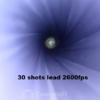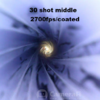PC and plating are more similar and if were including lube in the equation the the correct idea is interface materials. Lead alone is a very poor interface material so one of the three other interface materials are used.
Extended testing by fortunecookie45lc has shown to my satisfaction that there is no major advantage to accuracy with PC or traditional lube. If you have contrasting data I would be happy to check it out as these are ever evolving technologies, and to claim forever knowledge would be obtuse.
The case for the lubricated 45-70 PC bullets were in a 32" pendersoli I believe. Any further arguments beyond finding a successful path forward are just that argument with no first hand knowledge.
Any pressure curves showing a higher peak pressure from lead or jacketed would add a lot of value to this debate.
Not trying to argue at all. I'm glad you are relying on what others have wrote/stated rather then doing the leg work yourself.
Myself I'm using a 30" shilen match grade ss bbl chambered in .336" 308w match. I chose a 1 in 14 twist for that shilen barrel. I installed that bbl on my puma rifle along with rebuilding that rifles bolt and setting the head space to what I wanted. I cast and pc my own bullets. I see the results of my testing different alloys, lubes, pc powders, bake times for those powder, testing different temperatures of the baking of the pc powder. I also use a bore scope to actually see what's going on inside that shilen bbl.
None of what I do with cast and pc'd bullets is second hand, told by others, read about, etc. There's nothing wrong with reading about different testing. Just some of it comes up the complete opposite of what I did/test/saw 1st hand.
This is what that shilen bbl looked like after 30 shots using the lee TL312-160-2r bullet that I used traditional lubes on.

That 32" bbl'd 45-70 isn't going to get anywhere near those kind of velocities nor is it going to get anywhere near the 35,000psi+ of that 2600fps load pictured above.
Same lee bullet this time it had a pc coating. Did testing with H335 using 38.0gr, 39.0gr & 40.0gr loads. I started noticing black streaks in the bbl @ 2700fps & yes I check the bbl with a bore scope while testing at the range. This gives me real world results in real time. Didn't see to change much at 2900fps.

Turns out the burnt pc coating is common with several different colors the guy I bought the pc from sells. He had a list of colors that didn't do this when pushing bullets over 2700fps.
Anyway this is the only failure I've seen along with other people that pc their bullets over on the cast bullet website. I did a post on this very subject along with posting pictures. Those that had ran their cast/pc'd bullets over 2700fps chimed in & they pretty much had the same results.
There was no leading in the bbl, the pc didn't wear off down the length of the 30" bbl.
I stand by what I said about a 45-70 having issues with a pc'd bullet. That 45-70 simply can't push the pc'd bullet hard enough/fast enough. Nor can it exert the kinds of pressure on the pc'd bullet that a 308w can. That leaves the rate of twist between the 2 rifles and that shouldn't come into play with a 45-70 and it's low velocities.
You asked, I answered.
Take that lee bullet and compare it to a 165gr non-boattail partition bullet and go head to head with true rifle powder loads. With H335 I using 4 less grains to equal the max velocity of the jacketed bullet/max 42.0gr load.
You could always say that that pc makes 1 heck of a lube and look at how much less friction there is between the pc'd and jacketed bullet.



But for some odd reason the same cast bullet with traditional lube takes 2 1/2grains to get the same max velocity of the jacketed bullet. And as you already stated lead doesn't lubricate very well.





